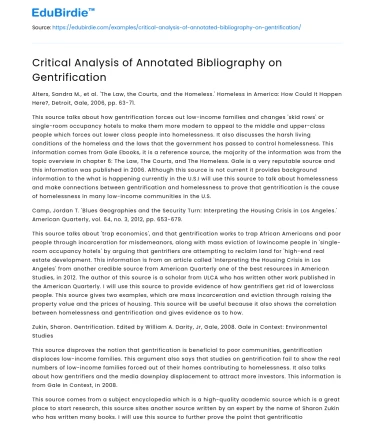Introduction
Gentrification, a complex and often contentious urban phenomenon, has garnered significant attention from scholars across various disciplines. This process, characterized by the transformation of low-income urban areas into affluent neighborhoods, raises critical questions about displacement, social justice, and urban policy. Annotated bibliographies serve as a crucial tool for researchers exploring this multifaceted topic, offering a curated list of sources with detailed annotations that evaluate the relevance and quality of each work. This essay provides a critical analysis of annotated bibliographies on gentrification, examining their role in synthesizing existing research, identifying gaps in the literature, and shaping future scholarly discourse. By analyzing diverse perspectives and methodologies, these bibliographies illuminate the complexities of gentrification and contribute to a nuanced understanding of its implications. Through this critical examination, the essay aims to assess the effectiveness of annotated bibliographies in advancing the academic conversation on gentrification and their potential in guiding policy decisions.
The Role of Annotated Bibliographies in Gentrification Research
Annotated bibliographies are instrumental in organizing and synthesizing the extensive body of research on gentrification, a subject characterized by its interdisciplinary nature and evolving dynamics. By providing concise summaries and critical evaluations of key sources, these bibliographies facilitate an understanding of the various dimensions of gentrification, including economic, social, and cultural impacts. For instance, Smith and Williams (2020) highlight the importance of annotated bibliographies in identifying seminal works that have shaped the discourse on gentrification, such as Neil Smith's theories on the rent gap and the role of capital in urban redevelopment.
Save your time!
We can take care of your essay
- Proper editing and formatting
- Free revision, title page, and bibliography
- Flexible prices and money-back guarantee
Furthermore, annotated bibliographies help researchers navigate the diverse methodological approaches employed in gentrification studies, from quantitative analyses of demographic changes to qualitative investigations of community experiences. This diversity is exemplified in the work of Lees et al. (2016), who compile an annotated bibliography that spans economic models, ethnographic studies, and policy analyses. By doing so, they provide a comprehensive overview of the field, enabling scholars to critically engage with various perspectives and identify methodological strengths and weaknesses.
However, it is essential to acknowledge the limitations of annotated bibliographies. Critics argue that these compilations may reinforce existing biases in the literature by privileging certain voices or perspectives over others. To mitigate this risk, annotated bibliographies must strive for inclusivity, incorporating diverse voices and perspectives that reflect the broader social and geographical contexts of gentrification. This approach not only enriches the academic discourse but also informs more equitable policy solutions.
Transitioning from the organizational role of annotated bibliographies, we must consider their impact on identifying research gaps and fostering new inquiries in the study of gentrification. This critical function is explored in the following section.
Identifying Research Gaps and Advancing Inquiry
A significant contribution of annotated bibliographies in gentrification research lies in their ability to uncover gaps in the literature, thereby guiding future scholarly inquiries and informing policy development. By systematically reviewing existing works, annotated bibliographies reveal areas that have been underexplored or lack comprehensive analysis. For example, an annotated bibliography by Zuk et al. (2017) identifies a paucity of research on the long-term social effects of gentrification on displaced communities, highlighting the need for longitudinal studies that examine the lasting impacts on social networks and community cohesion.
Moreover, annotated bibliographies can illuminate the intersectionality of gentrification, encouraging research that considers the interplay of race, class, and gender in urban transformations. The work of Freeman and Braconi (2019) is notable in this regard, as their annotated bibliography emphasizes the importance of examining how gentrification affects marginalized groups differently. This focus on intersectionality not only enriches the academic discourse but also informs more nuanced and inclusive urban policies that address the needs of diverse populations.
However, it is crucial to address counter-arguments that question the efficacy of annotated bibliographies in fostering innovative research. Critics argue that these compilations can perpetuate existing paradigms by focusing on well-trodden paths rather than encouraging novel approaches. To counter this, annotated bibliographies must be dynamic and reflective, incorporating emerging research and challenging prevailing assumptions. By doing so, they can serve as catalysts for transformative inquiry, pushing the boundaries of gentrification research and informing innovative policy solutions.
As we transition to the final section, it is imperative to consider the broader implications of annotated bibliographies in shaping scholarly discourse and public policy on gentrification.
Conclusion
In conclusion, annotated bibliographies play a pivotal role in advancing the study of gentrification by organizing existing research, identifying gaps, and fostering new lines of inquiry. Their ability to synthesize diverse perspectives and methodologies provides a comprehensive understanding of this complex phenomenon and informs more equitable urban policies. However, to maximize their impact, annotated bibliographies must strive for inclusivity and adaptability, incorporating diverse voices and emerging research. By doing so, they can challenge prevailing paradigms and contribute to a more nuanced and transformative understanding of gentrification.
Ultimately, the critical analysis of annotated bibliographies underscores their significance in shaping scholarly discourse and guiding policy decisions. By thoughtfully curating and evaluating existing research, these bibliographies illuminate the multifaceted nature of gentrification and its implications for urban development. As the study of gentrification continues to evolve, annotated bibliographies will remain an invaluable resource for scholars and policymakers seeking to address the challenges and opportunities presented by urban transformation.






 Stuck on your essay?
Stuck on your essay?

